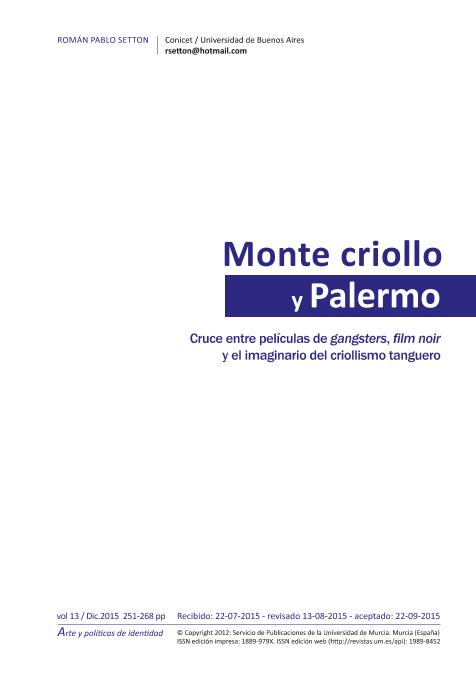Mostrar el registro sencillo del ítem
dc.contributor.author
Setton, Román Pablo

dc.date.available
2019-03-06T17:46:37Z
dc.date.issued
2016-01
dc.identifier.citation
Setton, Román Pablo; Monte criollo y Palermo. Cruce entre películas de gangsters, film noir y el imaginario del criollismo tanguero; Universidad de Murcia; Arte y Políticas de Identidad; 13; 1-2016; 251-268
dc.identifier.issn
1989-8452
dc.identifier.uri
http://hdl.handle.net/11336/71072
dc.description.abstract
El siguiente trabajo analiza las películas Monte criollo (1935) y Palermo (1937), de Arturo S. Mom como dos ejemplos de las primeras aproximaciones del cine argentino al género policial o crime film. En ese sentido, discutimos los modos en que estas películas trabajan, por un lado, con motivos del cine negro y de las películas de gangsters, es decir, los modelos del cine clásico hollywoodense y, por otro, cómo fusionan estas tradiciones con elementos propios de la cultura popular argentina contemporánea, los imaginarios del tango y del criollismo. A partir de esa fusión, algunos elementos que la tradición había colocado en el ámbito de la villanía son resignificados, tal como sucede con el dominio de la voz –que la tradición del gótico y del policial identificaban con el mal– que ahora, a partir de la heroicidad local del cantor de tangos, es ennoblecido. En este sentido, mostramos también de qué modo un crimen local concreto, el secuestro y asesinato de Eugenio Pereyra Iraola, modifica en el cine la representación de los criminales. A su vez, discutimos de qué modo estas películas reelaboran los arquetipos femeninos y masculinos de la época y proponen nuevos modelos de identidades genéricas.
dc.description.abstract
The following paper analyzes Arturo S. Mom´s movies Monte criollo (1935) and Palermo (1937) as two examples of the first approaches of Argentine cinema to the genre thriller or crime film. In that sense, I discuss the ways in which these films takes up, on the one hand, some topics and patterns of the film noir and the gangster movie, that is, models of Classical Hollywood Cinema, and on the other, merge these traditions with aspects of contemporary popular culture from Argentina, elements of Criollismo and tango tradition. In this hybridization, some motives that the literary and cinematic traditions had placed in the field of villainy are resignified, for example eloquence and the seduction of a nice voice-that in the gothic and detective fiction tradition were identified with evilness-are now ennobled, based on the premise of the tango singer´s heroism. I also try to show how a particular local crime, kidnapping and murder of Eugenio Pereyra Iraola, changes the film representation of criminals at that time, and, furthermore, how these movies discuss female and male archetypes of the time and propose new models of gender identities.
dc.format
application/pdf
dc.language.iso
spa
dc.publisher
Universidad de Murcia

dc.rights
info:eu-repo/semantics/openAccess
dc.rights.uri
https://creativecommons.org/licenses/by-nc-sa/2.5/ar/
dc.subject
Film Noir
dc.subject
Gangsters
dc.subject
Cine
dc.subject
Arturo S. Mom
dc.subject
Monte Criollo
dc.subject
Palermo
dc.subject
Cine Argentino
dc.subject
Criollismo
dc.subject.classification
Estudios Generales del Lenguaje

dc.subject.classification
Lengua y Literatura

dc.subject.classification
HUMANIDADES

dc.subject.classification
Otras Artes

dc.subject.classification
Arte

dc.subject.classification
HUMANIDADES

dc.subject.classification
Periodismo

dc.subject.classification
Comunicación y Medios

dc.subject.classification
CIENCIAS SOCIALES

dc.title
Monte criollo y Palermo. Cruce entre películas de gangsters, film noir y el imaginario del criollismo tanguero
dc.title
Monte Criollo and Palermo hybridization of gangster movies, film noir and the imaginary of Criollismo and Tango tradition
dc.type
info:eu-repo/semantics/article
dc.type
info:ar-repo/semantics/artículo
dc.type
info:eu-repo/semantics/publishedVersion
dc.date.updated
2019-02-27T12:48:07Z
dc.journal.volume
13
dc.journal.pagination
251-268
dc.journal.pais
España

dc.journal.ciudad
Murcia
dc.description.fil
Fil: Setton, Román Pablo. Universidad de Buenos Aires; Argentina. Consejo Nacional de Investigaciones Científicas y Técnicas; Argentina
dc.journal.title
Arte y Políticas de Identidad
dc.relation.alternativeid
info:eu-repo/semantics/altIdentifier/url/http://revistas.um.es/reapi/article/view/251001
dc.relation.alternativeid
info:eu-repo/semantics/altIdentifier/doi/http://dx.doi.org/10.6018/251001
Archivos asociados
